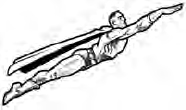Our Gods Wear Spandex (10 page)
Read Our Gods Wear Spandex Online
Authors: Chris Knowles



LITERARY LUMINARIES
At the same time the occult was infiltrating popular culture, advances in printing technology were creating new forms of mass entertainment. British picture-based “broadsheets,” printed woodcuts that addressed current affairs and gossip, spoke to an audience that was predominantly illiterate. These evolved into the “story sheets,” sensational prose fiction printed on a single sheet of oversized paper. And these, in turn, evolved into the “penny dreadfuls,” so named for their low cost and perceived literary quality. The penny dreadfuls, which appeared sometime in the 1830s, were usually eight pages long and sold to a mostly working-class audience, with salacious titles like
The Smuggler King
and
The Merry Wives of London
. Serial killer Sweeney Todd earned his own title in 1846, and other colorful stars soon emerged, including the occult-themed
Varney the Vampire
, which predated
Dracula
, and Spring-Heeled Jack, the first detective character with a secret identity, who appeared in 1867.
Variations on the penny dreadful appeared in American cities, where they morphed again into long-form prose as the dime novel. This format, which usually featured crude drawings to accompany the crude text, was pioneered by publishers Beadle & Adams during the Civil War, and became especially popular with Union Army soldiers hungry for cheap, accessible entertainment.
Early dime novels fictionalized real-life characters like Davy Crockett, Daniel Boone, Kit Carson, and Buffalo Bill and real-life cowgirl Calamity Jane. The rise of bandits like Billy the Kid and the James Gang, and the subsequent exploits of the ruthless Pinkerton Detective Agency, raised the prestige of lawmen and detectives in the American imagination and made them regulars in the popular press. One early dime-novel hero was Frank Merriwell, a wholesome schoolboy who moonlighted as a detective. Another was clean-living Nick Carter, who first appeared in
New York Weekly
in 1886 and later became a major pulp-fiction star.
The rise of this new mass medium created a new class of writers that specialized in the down-market fiction. The new junk aesthetic—violent, garish, racy, and often racist—found its apotheosis in the 20th century with the rise of comic books. But first, the genre was refined by the hands of master fiction writers—luminaries like Edgar Allan Poe, Arthur Conan Doyle, Jules Verne, H. G. Wells, and Bram Stoker, many of whom were fascinated by the occult.
Edgar Allan Poe (1809–1849) is perhaps the most important and influential figure in the development of modern genre fiction. Born in Boston to itinerant actor parents, Poe would die young. After being thrown out of the University of Virginia for gambling, he joined the army and was later dishonorably discharged from West Point. Despite this inauspicious beginning, however, Poe displayed a prodigious gift for writing and soon began a career as a literary critic.
Tragedy haunted Poe throughout his career. His marriage to his thirteen-year-old cousin ended in her early death, which critics believe inspired his epic poem
The Raven
, which was published in 1845. An 1840 short-story collection featured his tale
The Fall of the House of Usher
, a classic of the gothic horror genre.
The following year, Poe pioneered the detective story with
The Murders in the Rue Morgue
, which featured the French detective C. Auguste Dupin. His work had a crucial influence on Arthur Conan Doyle, creator of Sherlock Holmes, who claimed, “Each [of Poe's detective stories] is a root from which a whole literature has developed…. Where was the detective story until Poe breathed the breath of life into it?”
47
Poe's work also made a lasting impression on Jules Verne, H. G. Wells, and H. P. Lovecraft. Indeed, despite his short and unhappy life, his legacy has had an incalculable influence on almost every writer of genre fiction to follow.
Arthur Conan Doyle (1859–1930) was not only the creator of the most famous fictional detective in the English language, he was also Spiritualism's most prominent advocate. Born in Edinburgh to Irish parents, Doyle was educated at Jesuit-run schools. When he entered university, however, he renounced his parents' faith and became a spiritual tourist, dabbling in Theosophy, Rosicrucianism, Hermeticism, and Mormonism. He even became interested in fairies, in 1921 writing a book inspired by the Cottingley fairy photographs called
The Coming of the Fairies
. Doyle eventually became an opthamologist and was initiated into the Masonic order.
In 1887, Doyle made his first foray into popular fiction with
A Study in Scarlet
, which featured the debut of Sherlock Holmes. Doyle eventually wrote sixty stories featuring the aristocratic detective. Intellectually brilliant, a master of disguise, and physically adept in the gentlemanly fighting arts, Holmes was very much a superhero. Such was Holmes' prowess that Doyle felt obliged, in 1893, to create a prototype supervillain named Professor Moriarty who was worthy to act as his nemesis (
The Adventure of the Final Problem)
.
Following the death of his wife in 1906, and the loss of his son and several other male relatives on the killing fields of the first World War, Doyle turned to Spiritualism for solace. He wrote several books on the subject, including
The New Revelation
(1918),
The Vital Message
(1919), and
The History of Spiritualism
(1926). He became a regular contributor to the Spiritualist magazine,
The Light
and
traveled the world consorting with mediums, contributing money to Spiritualist organizations like the Society for Psychical Research, of which he became a member. He later included Spiritualist themes in his fiction, most notably his 1926 novel
The Land of Mists
. Such was Doyle's celebrity that he was named Honorary President at the 1925 International Spiritualist Congress in Paris. Upon his death, psychic researcher Harry Price wrote in the Spiritualist magazine
Psychic Research:
“The passing of Sir Arthur Conan Doyle … removes the greatest personality Spiritualism ever possessed—or is ever likely to possess.”
48

The French writer Jules Verne (1828–1905) is a pivotal figure in the history of science fiction. His novels married high adventure and heroic fantasy, and anticipated modern technology and space travel in such detail that some today consider him a prophet. Sci-fi legend Ray Bradbury observes that “we are all, in one way or another, the children of Jules Verne.”
49
Verne set out to study law, but found himself fascinated by breakthroughs in science and spent most of his free time reading up on geology, engineering, and astronomy. In 1863, he published his first novel,
Five Weeks in a Balloon
, which was followed in quick succession by what most consider to be his greatest classics:
Journey to the Center of the Earth
(1864),
From the Earth to the Moon
(1866),
Twenty Thousand Leagues Under the Sea
(1870), and
Around the World in Eighty Days
(1873).
Verne's fictional science is eerily accurate.
From the Earth to the Moon
tells the story of a group of scientists who devise a cannon capable of sending a capsule to the Moon. The Moon-shots are launched from Florida, not far from Cape Canaveral and, as with the Apollo missions, the returning space craft splashes down in the Pacific Ocean. In 1886, Verne predicted air travel and a militarily imposed new world order in
Clipper in the Clouds
. His unpublished work,
Paris in the 20th Century
, written in 1863, foretold steel skyscrapers, bullet trains, automobiles, calculators, and even a precursor to the Internet. Needless to say, the
manuscript caused quite a stir when unearthed in 1989. Significantly, Verne is believed to have been a Freemason and to have had contacts with both the Rosicrucians and the Golden Dawn.
50
A hundred years after they were written, Herbert George Wells' science fiction continues to attract audiences in big-budget Hollywood movies. Born in 1866 in England, Wells grew up poor, but distinguished himself as a brilliant student. At the age of 17, he became a teacher and obtained a scholarship to the Normal School of Science in London, where he studied biology under T. H. Huxley, who was nicknamed “Darwin's Bulldog” for his zealous defense of evolutionary theory. Wells wrote extensively on political and scientific topics before trying his hand at fiction.
The continuing power and appeal of Wells' fiction lies in its prescience. In 1895, his first novel,
The Time Machine
, anticipated Einstein's theory of relativity in its portrayal of the breaking of the time barrier. It also offered an inversion of the Vril-ya, presenting a future Earth inhabited by two races: the gentle Eloi who lived above ground, and the bestial cannibalistic Morlocks, who lived beneath it. In 1896, Wells published
The Island of Dr. Moreau
, which anticipated genetic engineering and recombinant DNA. The following year, he offered a character with a kind of superpower in
The Invisible Man
. One year later,
War of the Worlds
became the first popular novel to deal with the theme of interplanetary war, which became a staple topic of superhero comic books.
The First Men on the Moon
(1901) was prophetic in its description of the methodology of space flight and
The War in the Air
(1908) foresaw the importance of air forces in combat. Wells combined these two themes in his novel
The Shape of Things To Come
(1933), which was adapted into a remarkably advanced and prophetic film in 1936.
Things to Come
told of a disastrous world war that plunges Europe into a new Dark Age. Civilization is saved by a cabal of Airmen who go underground during the war and return to impose a new technocratic world order. In the film, the Airman Oswald Cabal (Raymond Massey) proclaims a
new order based on the “Freemasonry of Science.” The Airmen are depicted as superheroes and saviors of humanity, and salvation comes in the form of global federalism. “World government had been plainly coming for some years,” Wells wrote, “although it had been endlessly feared and murmured against, it found no opposition anywhere.”
51
Wells didn't live to see his prediction come true, and was severely disheartened by the Second World War.
Wells' greatest passion was for the idea of a new world order that offered science as the new religion. He had various contacts with spiritualists like the Theosophists and political radicals like the Fabian Socialists. He soon parted ways with the Fabians, however, and advocated instead an “open conspiracy” of world federalists. In 1928, Wells wrote: “The political world of the Open Conspiracy must weaken, efface, incorporate and supersede existing governments…. It will be a world religion.”
52
Science fiction was merely Wells' vehicle for popularizing his radical scientific and political ideas. Although he claimed to be an agnostic throughout whole life, books like
Things to Come
reveal the gods to whom he bowed.
